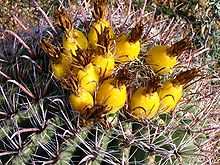- Ferocactus wislizeni
-
Ferocactus wislizeni 
Scientific classification Kingdom: Plantae (unranked): Angiosperms (unranked): Eudicots (unranked): Core eudicots Order: Caryophyllales Family: Cactaceae Genus: Ferocactus Species: F. wislizeni Binomial name Ferocactus wislizeni
(Engelm.) Britt. & RoseSynonyms Echinocactus wislizeni Engelm.
Ferocactus wislizeni, the fishhook barrel cactus, also called Arizona barrel cactus, candy barrel cactus, and Southwestern barrel cactus, is a cylindrical barrel-shaped cactus.
Contents
Characteristics
The fishhook barrel cactus typically grows to a diameter of roughly two feet and a height of three to six feet. However, specimens as wide as three feet and tall as ten feet have been recorded.[1] The common name comes from the spines, which are thick and hooked. It has a leathery asparagus green cortex (skin) with approximately 15-28 ribs per cactus. Its flowers are yellow to red-orange and appear atop the cactus fruit during the summer months. The fruits are green when unripe, yellow after the flower dries up, and persist atop the cactus long after the flower is gone, sometimes for more than a year.
In adulthood, fishhook barrel cacti generally leans southward, toward the sun, earning it the nickname "compass barrel cactus." One theory about why this happens is, the afternoon sun is so intense it slows the growth on the exposed side, causing the plant to grow unevenly. Older barrel can lean so far they uproot themselves and fall over especially after heavy rains when the soil is loose.[2] Its life cycle is 50-100 years.
Like Sclerocactus, Ferocactus typically grow in areas where water flows irregularly or depressions where water can accmulate for short periods of time. They are most often found growing along washes and arroyos where their seeds have been subjected to scarfication due to water movement, but they oddly also tend to grow along ridges in spots where depressions have formed and can hold water for some period of time.
The "fishhook" spines and the armored web of spines enclosing the cactus body in many species of this genus is an adaptation which allows the plant to move to more favorable locations. This plants seeds germinate in areas where water movement occurs or in areas where standing water accumulates for some period of time, and during flash floods, the hooked spines allow the plants to be caught on water bourne debris and be uprooted and carried to areas where water tends to accumulate. Ferocactus have very shallow root systems and are easily uprooted during flash floods.
The habitat these plants exist in is hot and very arid, and the plants have adapted to exploit water movement to concentrate their biomass in areas where water is likely to be present.
Distribution
The fishhook barrel cactus is native to southwestern United States and northern Mexico. More specifically, it can be found in southern Arizona, southern New Mexico, El Paso County, Texas and northern Sonora and Chihuahua, Mexico.[3] It grows in gravelly or sandy soil, more commonly on bajadas than steep slopes, at 1000 to 5300 feet (300-1600 m) elevation. It prefers full sun, and does well in hot arid climates. It is, however, frost-tolerant to 5 °F (-15 °C)[4]
Ecology
The flowers are pollinated by cactus bees (Lithurge spp.). Mule deer, birds, and javelina eat the fruit. The birds especially like the seeds. The people of the Sonoran desert use the fruit for candy and jelly.[3] The Seri eat the flowers and the O'odham use the fruit, which is sour, as emergency food.[2] Tradition says that the barrel cactus is a source of water for people lost without water in the desert. There are records of the southwestern Native Americans using it for that purpose,[5] But the water contains oxalic acid and is likely to cause diarrhea if ingested on an empty stomach.[6]
The skin thickens with age, making older cacti more fire resistant. Even so, average mortality due to fire is 50 to 67 percent within the first two years following fire.[3]
In urban areas, the Fishhook Barrel is valued as an ornamental plant. It is drought tolerant and good for xeriscaping, and it is also a low-maintenance full-sun plant.
External links
- Fishhook Barrel Cactus Pictures at BioImages.
- Fishhook Barrel Cactus Pictures at CalPhotos
- Map of Fishhook Barrel Cactus range
- USDA: NRCS Plants Profile Ferocactus wislizeni
- Ferocactus wislizeni at Flora of North America; RangeMap
References
- ^ Barrelcactus Cactacae Ferocactus wislizeni. USDA Fact Sheet.
- ^ a b Mark A. Dimmitt. Cactaceae (cactus family). Arizona Sonora Desert Museum.
- ^ a b c US Forest Service. Index of Species Information. SPECIES: Ferocactus wislizenii.
- ^ Philippe Faucon. Fishhook Barrel Cactus. Desert Tropicals.
- ^ Native American Ethnobotony.
- ^ Desert Museum
Categories:- Ferocactus
- Garden plants
- North American desert flora
- Flora of the Chihuahuan Desert
- Flora of Arizona
- Flora of New Mexico
- Flora of Sonora
- Flora of Chihuahua
- Flora of Northwestern Mexico
- Flora of the U.S. Rio Grande Valleys
- Cacti of Mexico
- Cacti of the United States
Wikimedia Foundation. 2010.


